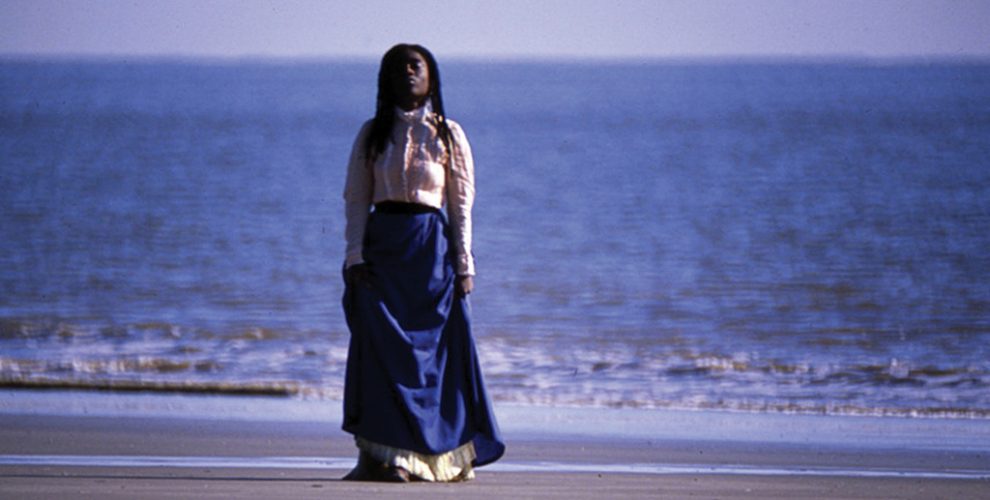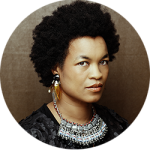Last week, I nervously sat down to interview a jet-lagged, but recovering Julie Dash the day after her arrival for the CinemAfrica 2017 film festival in Stockholm. As the interview progressed, I lost my nervosity and so much was said, that the editors at KRULL have decided to post it as a 3-part series.
Julie Dash first released her highly original and influential film “Daughters of the Dust” to wide critical and public acclaim in 1991. It became the first film by an African-American woman to get a general distribution deal. In 2004, “Daughters of the Dust” officially became a part of the U.S. permanent cultural canon when it was taken into the prestigious National Film Registry by the Library of Congress. The film was re-released last year and again became one of the must-see films of the year.
The story of the film is set in 1902 and centers on one day in the life of four generations of women in the Peazant family who live on one of the Gullah Islands off the east coast of the US. It’s a story of a pivotal post-slavery moment, when each member of the family must decide whether they should stay on the island or join the Great Migration of African-Americans to the North. Dash provides us with graceful and intimate tableaux allowing us to simultaneously understand the historical event and the personal choices each family member has to make.
Julie Dash embodies the fighting spirit of black women. That spirit that keeps us doing our thing, holding on to our ambitions in the face of rejection, neglect and what is expected of us. She has collected accolades in an industry that is notoriously hard on women and black women in particular. She has survived the film industry for over 25 years and her seminal work “Daughters of the Dust” have come full circle and is relevant to a new generation of black women the world over, thanks to Beyonce’s Lemonade drawing heavily from the visual language of the film.
Julie Dash changed how we saw black women in film.
“I always wanted to see a black woman riding off into the sunset with her lover and not being chased, so I put it in my film!”
 JULIE DASH, director, Stockholm 2017
JULIE DASH, director, Stockholm 2017
CURRENT & NEXT PROJECT
You’ve been traveling the film now, right? It’s a new master?
Yes, it’s been restored. This is like the tail-end of the festivals. We started last May (2016) in Cannes, then Toronto, London, Chicago, etc. So 2017 is the tail end of the re-release in 2016.
What are 3 words or concepts that sum up your work?
Re-imagination
Women
The culture of women of the diaspora.
“Daughters of the Dust” tells its story using a fluidity of time in its storytelling. What was your intention using that structure?
I wanted to grab the audience’s attention and tell them a story in a very different way. A story about African-American women, African-American families, that they had not been anaesthetized to over the years through television and Hollywood cinema. I used a structure I called my ‘griot structure’. And I let the story unravel in a way an African griot would recall and recount a family’s history, rather than using the structure of the ‘tall tale’ which is very Western.
Had you used this structure before? Had you tested it?
This was the test!
Has it become one of the tools in your toolkit of filmmaking?
I haven’t used it again, but I know now that it can be used. There are many ways of telling a story and I think over the last 25 years, we’ve seen that with other filmmakers of course. Structure can be what it is. Everything has a beginning, a middle, and an end, but it’s how you get to the beginning, middle and end. And what you do between the beginning and the end.
This film was such a significant breakthrough then. Now a new generation is embracing it. The message remains the same but has the audience changed?
The audience has changed. Most of them weren’t even born when “Daughters of the Dust” came out, but they were born into a world where music video editing and commercials were not always on the nose, or direct. I think the younger audiences are more comfortable. With audiences back in the 90s there was the shock of the new to some people, because they were comfortable with knowing how a story was going to unfold. Especially in African-American stories, because it’s very pedantic. But we changed all of that!
“I wanted to make a film so deeply embedded in tradition that it would feel like a foreign film even in the United States.”
That was one of the things that was a little bit shocking in 1991, that it wasn’t about slavery, rather the free people after. Because everybody expected that. Even now, with a lot of the slave movies that are coming out, yes, the stories need to be told, but there is an expectation of a certain amount of negativity, especially in an African-American film. How do you feel about that?
Yes, and people also expect a protest film. My film was not a protest film. It was more like science fiction. Speculative fiction. Here you have the first free born adults, African-Americans, at the turning point of their lives, the Great Migration (from the South to the North of the US). The Industrial Revolution had already begun…what do they do next? So, the whole thing was “what if”. Do you stay, or do you join in the wave of migration? Do you try to go North to science and industry? There was a little of the flotsam and jetsam of science coming to them via the photographer. He comes from Philadelphia taking pictures; he has the kaleidoscope; you have the stuff coming from the sea – the umbrella scene where they find the beach umbrella that floated across from the mainland. They had connections with the outside world but everything was murky and falling apart in little bits and pieces. The missionary coming over, the aunt, who is the Baptist person talking about Jesus Christ being over there and can’t wait to go. But the two women who returned, Yellow Mary and her friend the prostitute, they know what’s over there, what’s waiting.
It was a lot of inside comments and jokes and everything for African-Americans. A lot of other people didn’t get it, but maybe that’s OK too, because we need things to nurture us. That’s what I’ve always tried to do, speak directly to my community. Anyone else can watch and enjoy but I get so tired of seeing films that are explaining stuff that we already know. Because they are not made for us. They’re made to explain us to other people. And I get offended when I watch something and it’s like “Well, we know that!”
What are you working on now?
I’m working on “Travel Notes of A Geechee Girl”, a documentary about culinary anthropologist, Vertamae Smart-Grosvenor.
When I first saw the “Daughter of the Dust,” I thought they were speaking Jamaican patois, as it’s very similar. Is that what the Geechee girl project is about?
She was actually in the film, Vertamae Grosvenor. She was the woman wearing the hat all the time. She was a journalist at NPR (National Public Radio in the US), a travelling reporter. She lived in Sweden for a while; in Paris; she lived in all these places. So, the film is really about intersectionality. How a black woman who comes from the Geechee South grew up to cross so many border and boundaries, travel the world, write and comment about it, and also, she was a chef. Incredible!
How is the situation in Gullah islands?
Fewer and fewer people are fluent in the Gullah language, but there’s still about 250,000 people. The people on the islands were like the Maroons, because they were isolated for generations. Languages fused into Gullah, religion, culinary techniques, cosmologies, the knowledge and memory of planting, etc. remained close to what their ancestors brought over from West Africa.
photo Andrea Davis Kronlund






2 Comments
Gisela
Great Andrea! LOVE itXXg
andrea
Thanks Gisela! xA